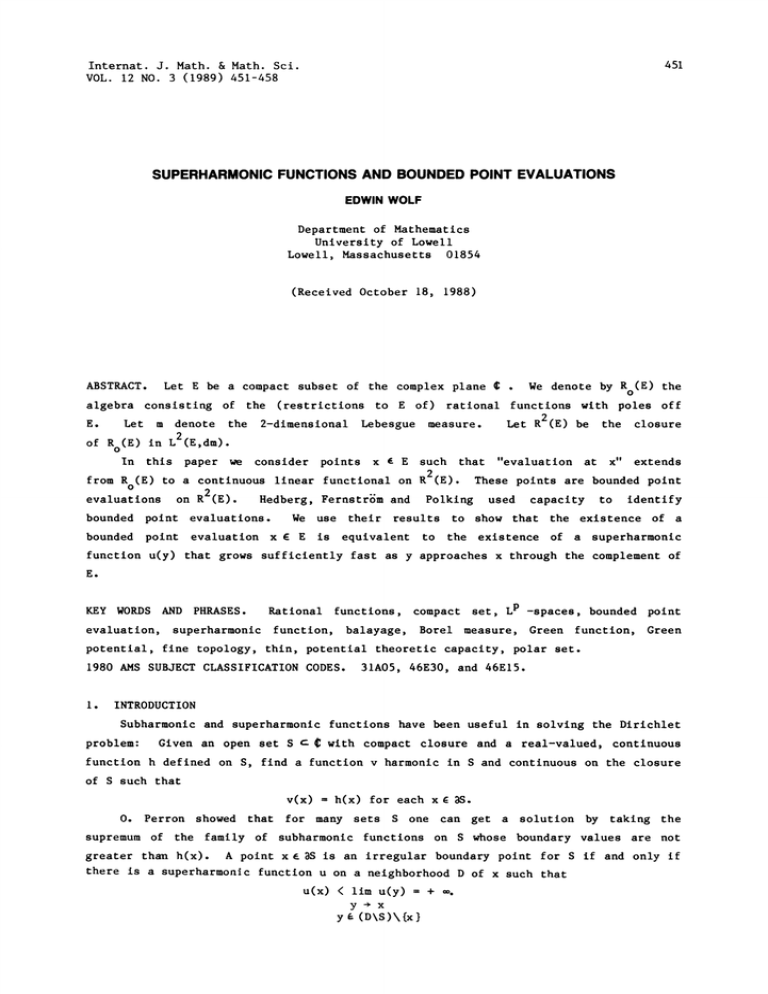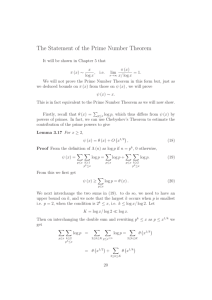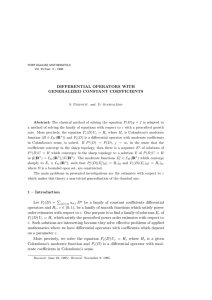Ro(E)
advertisement

451
Internat. J. Math. & Math. Sci.
VOL. 12 NO. 3 (1989) 451-458
SUPERHARMONIC FUNCTIONS AND BOUNDED POINT EVALUATIONS
EDWIN WOLF
Department of Mathematics
University of Lowell
Lowell, Massachusetts 01854
(Received October 18, 1988)
ABSTRACT.
Let E be a compact subset of the complex plane
We denote by
Ro(E)
the
algebra consisting of the (restrictions to E of) rational functions with poles off
E.
Let m denote the 2-dimensional Lebesgue measure.
be the closure
Let
R2(E)
of R (E) in
o
L2(E
din).
In this paper we consider points x
E such that "evaluation at x" extends
2
from R (E) to a continuous linear functional on R (E). These points are bounded point
o
evaluations
R2(E).
on
Hedberg,
bounded point evaluations.
bounded
point
Fernstrm
Polklng
and
used
capacity
to
identify
We use their results to show that the existence of a
evaluation x E E
is
equivalent
to
the existence of a superharmonlc
function u(y) that grows sufficiently fast as y approaches x through the complement of
E.
KEY WORDS AND PHRASES.
evaluation,
superharmonic
Rational
functions,
balayage,
function,
p
compact set, L -spaces, bounded point
Borel measure,
Green function, Green
potential, fine topology, thin, potential theoretic capacity, polar set.
1980 AMS SUBJECT CLASSIFICATION CODES.
I.
31A05, 46E30, and 46E15.
INTRODUCTION
Subharmonic and superharmonic functions have been useful in solving the Dirichlet
problem:
Given an open set S
=
with compact closure and a real-valued, continuous
function h defined on S, find a function v harmonic in S and continuous on the closure
of S such that
v(x)
h(x) for each
x S.
O. Perron showed that for many sets S one can get a solution by taking the
supremum of the family of subharmonlc functions on S whose boundary values are not
greater than h(x). A point x S is an irregular boundary point for S if and only if
there is a superharmonic function u on a neighborhood D of x such that
u(x)
<
lim u(y)
yx
yE (D\S)\
+
.
E. WOLF
452
We wlll be particularly interested in those superharmonlc functions that are the
Using these measures
Green potentials of measures supported on compact subsets of
we
will
define
Polking, and
a
capacity
Fernstrm
that
the Wiener
to
equivalent
is
Hedberg,
capacity.
have shown that this capacity is helpful in identifying bounded
For compact sets E c we will relate the existence of a bounded
2
on R (E) to the existence of a superharmonlc function in a
x
point evaluation
2
neighborhood of x. We wlll prove that x is a bounded point evaluation on R (E) if and
point evaluations.
only if there is a superharmonic function u such that u(x)
<
,
and
y e (D\E)\{x
where D is a neighborhood of x.
2.
SUPERHARMONIC FUNCTIONS AND BALAYAGE.
One way to define a superharmonlc function u is to say that u is superharmonlc if
and only if -u is subharmonlc.
function defined for
To be more specific let S
be open and let u(x) be a
xe S.
A function u(x) is called superharmonlc on S if for xE S
DEFINITION 2.1.
and u(x)
+
+
u(x)
(1)
(ll) u is lower seml-contlnuous, and
(Ill) u(x) ) 2 u(x + re le dO whenever the disk with radius
fO
r
>
0 and
center at x is contained in S.
superharmonlc in S.
Although superharmonlc functions need not be continuous, one can define a new
topology on
in which all superharmonlc functions are continuous.
The smallest such
A set E is thin at x if x is not a fine
The following theorem is part of Brelot’s contribution to potential
topology is called the fine topology.
limit point of E.
For the proof see[l, p. 210].
THEOREM 2.1. A set E is thin at a limit point x of E if and only if there is a
theory.
superharmonic function u on a neighborhood D of x such that
u(x)
<
llm u(y)
y
y
Later we will
construct
a
+
.
/x
(D\E)\ {x
montone
increasing
sequence {u i of superharmonlc
By a lemma in [I, p.68]
functions on a set S that is open in the ordinary topology.
sup u i is either harmonic or identically (R).
There is a way to associate with each non-negatlve superharmonlc function u on S
and each set E C S another superharmonlc function that dominates u on E and satisfies
a special property. This function can be defined so that when E is compact it equals
a potential with respect to the Green function of S.
Green function of S.
We begin by letting G be the
S
Let u be a non-negatlve superharmonlc function on S.
denote the class of superharmonlc functions on S.
If u
S
any subset of S, let
{V&4s:
Let R
u
E
inf
IV:
v
I.
v
)
0 on S, v
)
u on m}.
S
will
is non-negatlve and E is
453
SUPERHARMONIC FUNCTIONS AND BOUNDED POINT EVALUATIONS
satisfies (i) and (iii) of the definition of superharmonlc.
The function
R
u
By defining
E may not be lower semi-continuous.
(x)
we
get a function that
to E
relative
(x)
called the balayage_ of u
is
the following fact about
S is compact,
(x)
will be
i.e. there is a Borel measure B on S
is a Green potential,
such that
3.
(x)
superharmonic on S.
is
When E
in S.
useful [I, p.135]:
(y)
lira Inf
(x) fGs(x,y)d(y).
POTENTIAL THEORETIC CAPACITY.
C be compact and
Let E
be an open set having a Green function G S
is a superharmonic
on S. Then by [I, p.138]
Let S C
(x)
let u be the function identically
function on S that is the potential of a measure with support in E.
DEFINITION 3.1.
The measure
E
(x) GSE
for which
is
called the capacitar
distribution of E.
The capacity of E (relative to the set S) is defined to be
DEFINITION 3.2.
(E)
C(E)
C()
with
O.
For
The C capacity is equal to the Wiener capacity which we will denote by C 2
in
II].
Also,
7.19]
and
Chap.
[2,
Lemma
see [I,
more information on why C(E)
C2(E)
[3, p. 160]
it is shown that if E is a continuum with diameter d, there are positive
constants K
and K
,
only on the distance from E to
2 depending
K
/ (log
I/d#/2
C2(E)
K
1 Clog
2
such that
I/d#/2
series that converges at the points where the complement
2 capacity
is thin. To state this as a theorem we will need still more notation.
There is a C
of a set E C
Let j
<
k be positive integers.
Define
<
and
A[n, n+1].
Now let An
A[J,k]
{z :
..
’ [z
<
< 2 -j
The next theorem is due to Wiener [2]
about thinness at an arbitrary point x
that xffi0.
2 -k
z
.
It is a statement
We assume after a possible translation
The set E need not be compact
THEOREM 3.1.
(Wiener) Let E C
only if
Then the complement of E is thin at 0 if and
I nC2(An\E) <
Fernstrom and
Polking
nffil
used another C
2 series to identify bounded point
be compact and let R (E) denote the algebra of rational
o
functions with poles off E.
Let m be 2-dimensional Lebesgue measure
R 2 (E) will
2
denote the closure of
in the norm L (dm).
evaluations
[4].
Let E
C
Ro(E)
DEFINITION 3.3.
A point x e E is a bounded point evaluation (BPE) on
R2(E)
if
there is a constant C such that
E
theorem applies to an arbitrary point x
possible translation that x=0.
The next
.
o
We may assume after a
E. WOLF
454
THEOREM
Ferstrm,
(Hedberg,
3.2.
2
on R (E) if and only if
2
Polking)
and
2n
C
The
point
E
0
is
a
BPE
2(A\E) <
n--I
The existence of a BPE at O E is a local property; hence it is no restriction to
= {z: zl
assume that E
<I/ D.
GD(0,z)
The Green function for D is
-log
21z
{0.
D\
for z
We will need several lemmas to prove our theorem.
These are modified versions of
lemmas which can be found with their proofs in [I, Chap. I0].
LEMMA 3.1.
There is a constant b independent of j such that
og21y-zl
\f: 2-j-2
whenever y
1
b
2 -j-I
{:
and z
I 2-Jl for each
positive
3.
integer j
We ii consider two cases.
PROOF.
Case I.
2
2-j / llOg
[y[ > 2 -j+l,
e
(j-l)log2.
> 3.
The absolute value of
absolute
value
log2]y[
of
log2]y-z[
no
is
is no greater than
less
than
(J-2)log2.
us
value
than
(j+l)log2.
Thus the
the
quotient does not exceed (j-l)/(j-2).
2.
vaue.
log2]y]
reover,
is
LE 3.2.
in absolute
greater
Any b >
quotient does not exceed I.
will satisfy the statement of the lemma.
If S is an open set having a Green function G
open set havi a compact closure U C S, there is a measure
()
and
on U.
C2(U),
Let
PROOF.
{Uj
and U is a nonempty
S
such that
on
GS
be an increasing sequence of open sets th compact closures
= U such that
U.3
K.3
denote by
Now
Uj + U. Each set Kj has a capacitary distribution
C2(U) lira C2(Kj) lira Bj (Kj). Since C2(U) < -, the
j.
j
are uniformly bounded.
ere
ieh
measures
must be a subsequenee of the sequence
can assu to be the sequence itself and a measure
_fd j
j
which we
such that
ifd,
U
U
.
for every function f continuous on U.
We claim that B has support in
If not, there is a compact set S CU,
To get a contradiction, take a non-negatlve function
$, such that (S) > O.
on S and equal to 0 on 8U. for j sufficiently large.
f continuous on U I equal to
SO
iU
Then
>
(S)
fd
O.
with compact
the
Gs(X)
support to approximate
of
I.
a
capacitary
e
DEFINITION 3.4.
GS,
we see that
distribution G
iU
j
f
dj
0 for
Using continuous functions
GSj(x)
for
Sj(x)
Gs(X)
By
as j
sufficiently
large J;
proof is complete.
A set Z
is a polar set if there is an open set
function u superharmonic on U such that
e
is supported in
U, then xU. for all j sufficiently large.
definition
hence
j
This is contradiction.
sufficiently large j.
If x
Since each
{z:
u(z)
+
U Z and
a
Z.
next t lemmas will be useful in proving that a certain C 2 capacity series
converges.
SUPERHARMONIC FUNCTIONS AND BOUNDED POINT EVALUATIONS
LEMMA 3.3.
Let v be
a
measure
support F
having
possibly for a polar subset of F, then F)
depending only on
D
)
a on
F except
aC2(F).
For the proof see [I, p. 219].
LEMMA 3.4. If v is a finite measure on D such that v
is a constant
If G
D.
455
GD is
finite at 0, there
such that
f GD(Y,z)dx)
a
DA(J-I, j+2)
A[J, j+l].
D
for all y
PROOF
inequality
Since
with G
-logly-zl, we
replaced by -logly-z
GD(Y,Z)
D
may
prove
the
by
lemma
proving
the
By Lemma 3.1. there is a constant b,
3, such that
independent of j
D\A(J-I, j+2)
D\A(J-I, J+2)
< -b flog2[yldy) + (log2) v(V)
DkA(J-I, j+2)
-b log21yldy) + (log2) (D)
D
for all
z&D A[J, j+l].
can take a
-b
Since we have assumed that
f log2[yld(y)
+ (log2)(D).
D
4.
THE MAIN THEOREM.
Let E
be compact
-
log2[yldv(y)
is finite, we
D
The property of being a BPE on
R2(E)
is local property and
In stating our theorem about an arbitrary point x E,
we my therefore assume that E C {Z:
< d/}= D and that x =0. We will combine
is invarlant under translation
zl
Theorem 3.2. with ideas of Wiener and Brelot to prove:
THEOREM 4.1. The point 0 6 E is a BPE on R 2 (E) if and only if there is a function
<
u superharmonic in D such that u(O)
=, and
y
Suppose that 0
PROOF
D\E
2
E is a BPE on R (E).
Then by Theorem 3.2.
"C(n\)
[
Let
{n
< -.
be a sequence of positive numbers such that
22 n <(R)1%
n=l
For each n >
let U be a nonempty open subset of D containing
n
U
D and the following conditions hold:
n
(i)
Un 1:[[
<
n+2
C2(Un) < C2(An\E)
*
+
n
and
An
E such that
E. WOLF
456
22nc2(Un
Then
n=2
<
We will obtain the required function u as the limit of a sequence of superharmonlc
functions.
Let G denote the Green function for D.
By Lemma 3.2. there is a
measure
n with
support in 3Un such that
C2(U n),
Bn (Jn)
and
on
Gnffi
Un.
We have
-log2{z}dln(Z)
G%(O)-- u G(O,z)din(Z)-- U
n
n
g
.
(n+l)(log2)2(Un).
m
>
For m
the u
m
I, define u m
2
((n+l)log2) -I Gn.
2n+2
nffi2
tend to a function u that
Gn
Since
on
Un An
is
By a remark
in Section 2
superharmonlc in D and satisfies u(O)
<
\ E,
u
for each k > 2
Vn (n)
(n+l)(log2)
> 2 2k+2 ((k+1)log2) -1
U
on
C\E
A\E
n
Thus
yD\E
Now suppose there is a function u superharmonic in D such that
u(0)
<
and
D\E
y
The function u is lower semi-contlnuous on D; hence we may assume by taking a smaller
D if necessary that u is positive on D. Moreover, the Rlesz Decomposition Theorem
implies that u= G
+ h where
D, and h is harmonic in D.
By Theorem 3.2. it suffices to show
is a measure supported on
Since h is bounded, we may assume that
that
[
uffi
G.
22nC2(An\ E)
<
For n > 2 consider the open sets
Un
and the sets Vn
U (
n
(An\E).
{z:
u(z)
.
Since V
nffi2
Let Kn be a compact subset of
>
Vn such
n
2 2n
nlog2
it suffices to show that
An\E,
22nc2(vn)
An\E
<
that
C2(Kn) > C2(Vn)-
n
SUPERHARMONIC FUNCTIONS AND BOUNDED POINT EVALUATIONS
457
Then it is sufficient to prove that
22nC2(Kn) <
n-2
.
(R).
One way to prove that this series converges is to prove that
28n+2 C2 (K4n+ ) <
=0, I, 2, and 3. We will do this for
Let K be the compact set defined by K-
for
u(0) >
(0)ffi w(0),
support in K[I, p. 135].
K4n
G(.,z)d(z) +
w
K4n
2-4 -2 <
c
{z:
2 -4n-3
Suppose that mn. Then
2 -4m-3
K4mC:[z:
<
If mffin+k with k
2 -4m
>
K4n
I’-I
2 -1
<
n
> 2, are disjoint.
<
zl
<
2
-4n}
2-11-I 2 -4m}
0, then
2 -4n-4k
<
2 -4n-3
2 -4n-3
and
<
2-11z[ < 2-4n}.
2 -4n+4k-3
>
2 -4n
2 -4n-3
<
2-lffil < 2-4n}.
K4m-D\ {z:
f
K4m
mn
provided we can show that the sets
V4n A4n,
w-
4n
Now w is the Green potential of a measure v wlth
We note that (D \
0 because w(0) <
For each
w(0)<
n 2
Since
-
U
n>2
0; the 3 other cases are similar.
K
U {0 }. Let
Since
If mfn-k with k> 0, then
2 -4m-3
K4m6_ D\{z:
and
In either case K4mD\A(4n-I 4n+2). The sets
n > 2, are disjoint.
Since U K4mDA(4n-I 4n+2), Lemma 3.4. implies there is a constant /3 depending
K4n
only on
such that
for all y6D
A4n
U
f
K4m
G(y,z)d(z)
/3
Thus
w(y) < /3 +
for all
set
yD
ZC K.
Thus
A4n.
f G(y,z)d(z)
K4 n
The functions w and u are equal on K except perhaps for a polar
458
E. WOLF
y. K\Z
Choose an integer N such that
o
28n
4nlog2 > B
Then
f
G(y,z)du(z)
K4n
LEMMA 3.3.
-
"
Hence
for all
Y6K4n\Z
nv(K4n)
o
nC2(K4n)
2
6)C2(K4n
nlog2
By
o
nN
converges
2
BC2(K4n)"
(4n12
o
because
. .
.
nv(K4n)
Now
the
hypothesis
nffi2
n2
Thus the series
.
(4n-1)log2v(K4n)
on
u
implies
that
the
It remains only to show that
converges.
-flog21z[d(z)
Note that
No
for all n
complement of E is thin at 0, and Theorem 3.1. applies.
the series
This completes
N
and n
8n
n>N
series
8n
4nlog2
8n
v(K4n)
The
2
No
for n
f -log2[zld(z)
K4n
(4n-1)(log2)(Kn).
converges, and so does the series
t2proof,
n=l
nv(K4n).
REFERENCES
I.
2.
3.
4.
HELMS, L.L., Introduction to Potential Theory, Robert E. Krleger Publishing
Company (1975).
LANDKOF, N,S., Foundations of modern Potential Theory, translated from the
Russian by A.P. Doohovskoy, Sprlnger-Verlag (1972).
HEDBERG, L.I., Approximation in the mean by analytlc functions, Trans. Amer.
Math. Soc., 163, (1972), 157-171.
FERNSTROM, C. and POLKING, J.C., Bounded point evaluations and approximation
in L
p
by solutions of elliptic partial differential equations, J. Functional
analysis, 28, (1978), 1-20.






![[Topology I, Final Exam — Solutions] The exam consists of 6](http://s3.studylib.net/store/data/008081748_1-8fb9b7a2e2e854f9954d0c709155560e-300x300.png)

